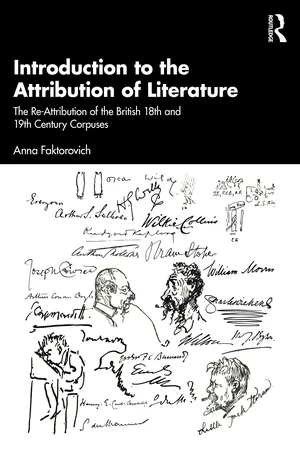
Introduction to the Attribution of Literature
The Re-Attribution of the British 18th and 19th Century Corpuses
- English
- ePUB (mobile friendly)
- Available on iOS & Android
Introduction to the Attribution of Literature
The Re-Attribution of the British 18th and 19th Century Corpuses
About this book
Introduction to the Attribution of Literature describes the first unbiased and accessible authorship attribution method, and uses it to present the first accurate re-attribution of 311 canonical texts from the 18th century to only 10 ghostwriters, and 323 texts from the 19th century to 11 ghostwriters. For example, the little-known Sir Francis Cowley Burnand is chronologically, stylometrically, and with handwriting analysis, proven to be the ghostwriter behind 55 canonical tested texts, including "Emily Bronte's" Wuthering Heights, "Collins'" Woman in White, "Doyle's" Sherlock Holmes, "Kipling's" Captain Courageous, "Stoker's" Dracula, "Anthony Trollope's" American Senator, "Wells'" Island of Doctor Moreau, "Wilde's" Picture of Dorian Gray, and "Dickens'" Great Expectations. This method applies a combination of 23 to 28 different types of punctuation, parts-of-speech, and lexical linguistic tests. Parts of this book offer extensive statistical evidence in support of why this method's findings are quantitatively reliable. If preceding attribution methods had been equally reliable; then, they would have also concluded canonical British texts have been overwhelmingly ghostwritten. A section in this book explains the methodological flaws of these preceding attribution approaches, because of which they have incorrectly reaffirmed their canonically-accepted bylines. It includes definitions of central stylometric terminology, and explains how readers can apply the described strategies to their own attribution research at any academic level.
Frequently asked questions
- Essential is ideal for learners and professionals who enjoy exploring a wide range of subjects. Access the Essential Library with 800,000+ trusted titles and best-sellers across business, personal growth, and the humanities. Includes unlimited reading time and Standard Read Aloud voice.
- Complete: Perfect for advanced learners and researchers needing full, unrestricted access. Unlock 1.4M+ books across hundreds of subjects, including academic and specialized titles. The Complete Plan also includes advanced features like Premium Read Aloud and Research Assistant.
Please note we cannot support devices running on iOS 13 and Android 7 or earlier. Learn more about using the app.
Information
Table of contents
- Cover
- Half-Title Page
- Endorsements
- Title Page
- Copyright Page
- Table of Contents
- List of Figures
- List of Tables
- Introduction
- Part I The New Stylometric Attribution Method
- 1 Anti-Assumptions as Pre-Requisites for Computational Stylometry
- 2 The Steps of the Recommended Stylometric Attribution Method
- 3 Selecting a Suitable Corpus
- 4 Preparing Texts for Testing
- 5 Reasons for the Use of Free Accessible Software
- 6 Discussion of the Data in the 18th and 19th Century Corpuses
- 7 A Method for the Quantitative Selection of the Most Likely Ghostwriter in a Linguistic-Group
- Part II Experiments to Explain Weaknesses of Previous Attribution Methods
- 8 Thomas Mendenhall’s Visual Curve Word-Length Comparison Model (1887)
- 9 George Udny Yule’s Sentence-Length Ranges and Statistics Model (1939)
- 10 George Udny Yule’s Vocabulary Model (1944)
- 11 Zhao and Zobel’s 634-Text Corpus (2007)
- Part III Experiments to Verify the New Method’s Accessibility and Accuracy
- 12 Statistical Comparison of Standard versus Newly Proposed Stylometric Methodologies
- Index